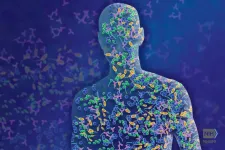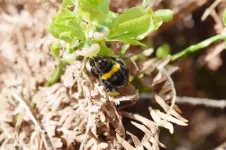Cold weather cost New England electric customers nearly $1.8 billion in one month; A new study suggests ways to mitigate fuel shortages
2021-06-23
(Press-News.org) In New England, constraints in the supply of natural gas have led to nearly a quarter of all unscheduled power plant outages. In a new study, researchers used data from power plant failures in the 2010s to develop a supply curve of the costs required for generators to mitigate fuel shortages in the region. The study found that storing both oil and gas on-site could reduce dependence by power plants on gas grids in geographic areas with few pipelines.
The study was conducted by researchers at Carnegie Mellon University (CMU), The Pennsylvania State University, and the North American Electric Reliability Corporation. It is published in The Electricity Journal.
"Gas supply issues have affected the ability to generate electricity during times of high demand," says Jay Apt, Professor at CMU's Tepper School of Business and Department of Engineering and Public Policy, who co-authored the study. "For example, it's estimated that the extended cold weather event in January 2014 cost New England electricity ratepayers roughly $1.8 billion."
New England has no native gas production, so fuel assurance for natural gas power plants is an area of concern; half of all installed power plant capacity in the region is fueled primarily by gas and nearly half of all electricity comes from natural gas power plants. When heating demand spikes on key gas supply pipelines to the region, those pipelines cannot always meet all the region's heating demand and demand for power-plant fuel at the same time.
The effect of gas supply constraints on Northeastern power generators can be seen by comparing the average fraction of total unscheduled generator outages due to gas fuel unavailability to those during days of high demand for heating. In recent periods of high electricity and gas demand, unscheduled gas shortages accounted for 5 to 25 percent of all unscheduled generator outages during every hour of those periods.
Dual fuel capability--that is, the ability to burn either oil or gas--is one way to mitigate gas supply shortages, and about a third of ISO New England's natural gas power plant capacity has dual fuel capability (ISO New England is an independent, not-for-profit corporation that manages the high-voltage power system over six New England states). But building dual fuel storage tanks for the remainder has been considered prohibitively expensive.
In 2019, one of the study's coauthors--Seth Blumsack, Professor of Energy Policy and Economics at The Pennsylvania State University--developed a model to identify where to build distributed gas storage capability in New England. To increase reliability of the interdependent gas and electricity grids, Blumsack and his students identified economically optimal sites for distributed gas storage in the region. They concluded that power plant sites might be the optimal locations for gas storage.
In this study, researchers analyzed a database of historical power plant failures, using data from the North American Electric Reliability Corporation--NERC--a not-for-profit international reliability organization. They determined what the cost of on-site fuel storage at natural gas power plants would have to be to mitigate the worst gas shortages in New England during the seven years studied.
The study assessed 54 gas-fired units operating within ISO New England that had NERC reports of full or partial outages due to unscheduled fuel shortages between 2012 and 2018. For each unit, researchers calculated the overnight capital, fuel carrying, and land costs (when applicable) required for gas generators in the region to assure that fuel supplies using fuel storage systems were sized according to their most extreme fuel shortage failure during the study period. They also examined distributed compressed natural gas storage at generator sites and dual fuel capabilities with oil storage. The researchers compared these costs to those of installing batteries with enough capacity to cover historically observed fuel outages.
The researchers found that approximately 2.4 gigawatts (GW) of ISO New England's gas-fired capacity failed one or more times per year due to fuel shortages; up to 0.5 GW of these units failed simultaneously on three separate occasions. Of these, approximately 2 GW of gas-fired capacity could be mitigated by on-site fuel storage. Furthermore, gas plants would recoup their investment in oil backup fuel if they were compensated with an additional $3 to $7 per megawatt-hour (MWh) during their normal operations.
Using on-site compressed natural gas storage is more expensive ($7 to $16/MWh). The capital expenses associated with either on-site fuel storage option would be less than installing battery backup for resource adequacy at current battery prices, the study concluded.
"Our estimates differ from previous studies because they are based on actual failure events rather than arbitrary fuel supply durations," explains Gerad Freeman, an Energy Systems Research Engineer at Pacific Northwest National Laboratory, the study's lead author. "As such, they have implications for moving forward on increasing dual fuel capacity to increase the resilience of power systems in New England and other regions with similar gas supply constraints."
The authors note that limitations to this research include that they may oversize the dual fuel storage by basing fuel storage tank sizes on the longest observed gas outage at each unit, that batteries can receive some revenue by providing grid services during non-emergencies, and that compressed natural gas storage might help balance gas supply and demand.
INFORMATION:
The study was funded in part by the Carnegie Mellon Climate and Energy Decision Making Center, formed through a cooperative agreement between the National Science Foundation and CMU, and in part by the Electric Power Research Institute.
ELSE PRESS RELEASES FROM THIS DATE:
2021-06-23
Toronto - Last winter, Goldman Sachs reported it was working to make things better after a group of junior analysts revolted against 100-hour work weeks.
That's a smart thing to do, suggests a new study from the University of Toronto's Rotman School of Management. Drawing from more than 6,000 employee reviews of their workplaces and data on their firms' forecasting accuracy, the research shows that making improvements to hardworking analysts' work-life balance produces dividends for the company and for the analysts' careers.
"There is a lot of anecdotal evidence, but here we provide large-scale evidence that supports the recent push to grant these employees at least some reprieve from the extremes of their jobs," said Ole-Kristian Hope, who is the Deloitte Professor of Accounting ...
2021-06-23
The Gerontological Society of America's highly cited, peer-reviewed journals are continuing to publish scientific articles on COVID-19. The following were published between May 4 and June 14; all are free to access: Cardiometabolic therapy and mortality in very old patients with diabetes hospitalized due to COVID-19: Research article in The Journals of Gerontology, Series A: Biological Sciences and Medical Sciences by Jose Manuel Ramos-Rincón, MD, PhD, Luis M. Pérez-Belmonte, MD, PhD, Francisco Javier Carrasco-Sánchez, MD, PhD, Sergio Jansen-Chaparro, MD, PhD, Mercedes De-Sousa-Baena, MD, José Bueno-Fonseca, MD, ...
2021-06-23
Best known for its presence in house cats and a tendency to infect and alter the behaviors of rodents and humans, the parasite Toxoplasma gondii (T. gondii) is also associated with bold behavior among wild hyena cubs and risk of death during interactions with lions, finds new research from the University of Colorado Boulder.
The findings, published this week in Nature Communications, reinforce previous research which has found the parasite can prompt profound behavioral changes in its hosts, and potentially in the 2 billion people worldwide estimated to be infected by it. While T. gondii has been well studied in laboratory settings with humans and wild-caught ...
2021-06-23
Researchers from Charité - Universitätsmedizin Berlin and the University of California in San Francisco were able to show for the first time that a very low calorie diet significantly alters the composition of the microbiota present in the human gut. In a current Nature* publication, the researchers report that dieting results in an increase of specific bacteria - notably Clostridioides difficile, which is associated with antibiotic-induced diarrhea and colitis. These bacteria apparently affect the body's energy balance by exerting an influence on the absorption of nutrients ...
2021-06-23
WHAT:
National Institutes of Health scientists and their collaborators have identified an internal communication network in mammals that may regulate tissue repair and inflammation, providing new insights on how diseases such as obesity and inflammatory skin disorders develop. The new research is published in Cell.
The billions of organisms living on body surfaces such as the skin of mammals--collectively called microbiota--communicate with each other and the host immune system in a sophisticated network. According to the study, viruses integrated in the host genome, remnants of previous infections called endogenous retroviruses, can ...
2021-06-23
Researchers at the RIKEN Center for Brain Science and the RIKEN BioResource Research Center in Japan, along with collaborators at the State University of New York at Buffalo, have created a mouse model that allows the study of naturally occurring melatonin. Published in the Journal of Pineal Research, these first experiments using the new mice showed that natural melatonin was linked to a pre-hibernation state that allows mice to slow down their metabolism and survive when food is scarce, or temperatures are cold.
Melatonin is called "the hormone of darkness" because it's released by the brain in the dark, which usually means at night. It tells the body when it's dark outside so that the body can switch to 'night mode'. Although other hormones are easily studied in the laboratory, ...
2021-06-23
How many tree species are there in the forest? How are the trees scattered throughout? How high are the individual tree crowns? Are there fallen trees or hollowed-out tree trunks? Forest scientists characterize forests according to structural factors. "Structural richness is very important for biodiversity in forests. But forests used for forestry are generally poor in terms of structure," says Tristan Eckerter from the Chair of Nature Conservation and Landscape Ecology at the University of Freiburg. Therefore, together with research teams from the Chair of Silviculture and the Black Forest National Park, he investigated ...
2021-06-23
A new article published in the Journal of the Association for Consumer Research presents a neural model of maladaptive consumption.
Consumption (of, for instance, substances, food, and online media) is driven mainly by expected rewards that stem from the ability of the consumption act to satisfy intrinsic (e.g., curiosity) and extrinsic (e.g., job performance) needs. In the article, "A Triple-System Neural Model of Maladaptive Consumption," the authors define maladaptive consumption as a state of compulsive seeking and consumption of rewarding products or experiences, which are sustained despite the negative consequences of such behaviors.
"Understanding the neural basis of maladaptive ...
2021-06-23
Pairing blueberry pie with a scoop of ice cream is a nice summer treat. Aside from being tasty, this combination might also help people take up more of the "superfruit's" nutrients, such as anthocyanins. Researchers reporting in ACS' Journal of Agricultural and Food Chemistry show that α-casein, a protein found in cow's milk, helped rats absorb more blueberry anthocyanins and their byproducts, boosting accessibility to these good-for-you nutrients.
In studies, anthocyanins have been shown to have antioxidant properties, lower blood pressure and reduce the risk of developing some cancers. However, only small amounts of these nutrients are absorbed ...
2021-06-23
For patients who have inflammatory bowel syndrome (IBS), the condition is literally a pain in the gut. Chronic -- or long-term -- abdominal pain is common, and there are currently no effective treatment options for this debilitating symptom. In a new study in ACS Pharmacology & Translational Science, researchers identify a new potential source of relief: a molecule derived from spider venom. In experiments with mice, they found that one dose could stop symptoms associated with IBS pain.
The sensation of pain originates in electrical signals carried from the body to the brain by cells called ...
LAST 30 PRESS RELEASES:
[Press-News.org] Cold weather cost New England electric customers nearly $1.8 billion in one month; A new study suggests ways to mitigate fuel shortages





